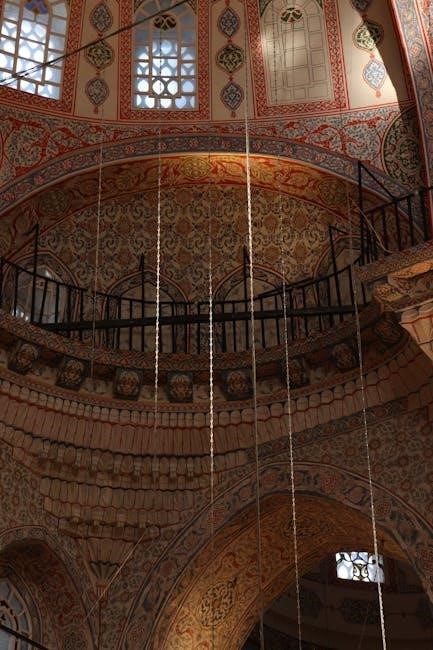Discover the unconventional strategies from Cal Newport’s “How to Become a Straight-A Student” to achieve academic success with less stress and more free time.
Overview of the Topic
The topic of becoming a straight-A student has gained significant attention, particularly through Cal Newport’s book, which offers unconventional strategies for academic success. Many students struggle with balancing studies, social life, and personal growth, often leading to stress and burnout. Newport’s approach emphasizes the importance of understanding how to study effectively rather than just studying harder. By focusing on task prioritization, time management, and building strong relationships with professors, students can achieve top grades without sacrificing their well-being. The book also highlights the role of intention and effort over raw intelligence, providing practical advice for students to optimize their learning processes. This approach has resonated with many, offering a fresh perspective on how to excel academically while maintaining a balanced lifestyle.
Importance of Becoming a Straight-A Student
Becoming a straight-A student offers numerous benefits beyond academic recognition. It fosters a strong work ethic, enhances time management skills, and cultivates self-discipline. Achieving top grades can lead to increased confidence, improved problem-solving abilities, and a competitive edge in future endeavors. Straight-A students often gain access to scholarships, prestigious programs, and leadership opportunities, which can significantly shape their careers. Additionally, mastering effective study habits and understanding professors’ expectations can reduce stress and lead to a more balanced lifestyle. The skills acquired, such as prioritization and consistency, are valuable in both academic and professional settings. Ultimately, becoming a straight-A student is not just about grades; it’s about personal growth, skill development, and unlocking future potential.

Key Principles from the Book
Cal Newport’s book emphasizes effective time management, strategic study habits, and understanding professors’ expectations to achieve academic success without overworking.
Understanding the Author’s Background
Cal Newport, the author of How to Become a Straight-A Student, is a renowned writer and speaker on productivity and education. He studied at Dartmouth College, where he developed an interest in understanding how students achieve academic success. Initially, Newport struggled with balancing academics and extracurricular activities but later discovered strategies that helped him excel. His curiosity led him to research and interview top-performing students, uncovering unconventional techniques that allowed them to succeed without overworking. This research formed the foundation of his book, which offers practical advice for students aiming to improve their grades and reduce stress. Newport’s background combines academic rigor with real-world insights, making his approach relatable and effective for students seeking to enhance their academic performance.
Core Strategies for Academic Success
Cal Newport’s book outlines practical strategies to help students achieve academic excellence. One key approach is focusing on understanding over mere memorization, emphasizing deep engagement with material. He advocates for active reading techniques, such as annotating and summarizing, to enhance comprehension. Additionally, Newport stresses the importance of concise note-taking, ensuring students capture essential ideas without overwhelming detail. Time management is another critical aspect, with strategies like prioritizing tasks and avoiding procrastination. Newport also introduces the concept of the “Law of the Vital Few,” suggesting that a small number of efforts often yield the majority of results. By implementing these strategies, students can optimize their learning process, reduce stress, and achieve higher grades more efficiently. These methods are designed to promote long-term academic success while maintaining a balanced lifestyle.
Effective Study Habits and Time Management
Cal Newport’s strategies emphasize active reading, concise note-taking, and task prioritization to maximize efficiency. He advocates for minimizing distractions and focusing on high-impact efforts to achieve academic success.
How to Prioritize Tasks Effectively
Cal Newport emphasizes the importance of identifying and focusing on high-impact tasks to maximize productivity. He suggests breaking down large assignments into smaller, manageable steps, allowing students to tackle them systematically. By prioritizing tasks based on deadlines and importance, students can avoid overwhelmed and maintain consistency. Newport also advocates for eliminating distractions during focused work sessions, ensuring that time is used efficiently. Additionally, he recommends regularly reviewing and adjusting task lists to align with academic goals. This strategic approach helps students allocate their time wisely, ensuring they complete high-value work without sacrificing quality. By mastering task prioritization, students can achieve more with less effort, creating a balanced and productive academic routine.
Mastering Time Management Techniques
Effective time management is crucial for balancing academic demands and personal life. Cal Newport advocates for techniques like time blocking and focused study sessions to maximize productivity. He suggests scheduling tasks in fixed intervals, minimizing distractions during work periods, and using tools like calendars or planners to stay organized. By allocating specific times for studying, relaxation, and leisure, students can maintain a healthy work-life balance. Newport also emphasizes the importance of avoiding multitasking, which can reduce efficiency and increase stress. Regularly reviewing and adjusting schedules helps ensure tasks align with academic goals. These strategies enable students to manage their time wisely, reducing procrastination and improving overall academic performance while maintaining mental well-being.

Setting Clear Academic Goals
Setting clear academic goals is essential for achieving success and maintaining focus. Cal Newport emphasizes the importance of establishing specific, measurable, and achievable objectives. Start by defining what you want to accomplish in each course, ensuring your goals are specific and time-bound. For instance, aim to earn an A in a particular subject or complete a challenging project by a certain date. Break larger goals into smaller, manageable tasks to avoid overwhelm and track progress effectively. Prioritize tasks based on importance and urgency, using techniques like the Eisenhower Matrix to focus on what truly matters. Regularly review and adjust your goals to stay aligned with your academic and personal values. Celebrate small victories along the way to maintain motivation and reinforce positive habits. By setting clear, actionable goals, you create a roadmap for success and foster a sense of accomplishment.

Understanding Your Professors’ Expectations
Aligning with professors’ expectations is crucial for academic success. Review syllabi, actively participate in class, and seek clarification on assignments to meet their standards effectively.
How to Build Strong Relationships with Professors
Building strong relationships with professors is essential for academic success. Attend office hours regularly to discuss topics and seek guidance. Actively participate in class to show engagement. Ask insightful questions and request feedback on assignments. Be proactive in communicating your goals and challenges, demonstrating your commitment to learning. Show genuine interest in their expertise by engaging in meaningful conversations. Additionally, follow up on their advice and maintain professionalism in all interactions. These strategies foster trust and support, creating a positive academic environment. By investing time and effort into these relationships, you gain valuable mentorship and opportunities that enhance your academic journey.

Study Basics and Assignment Strategies
Mastering study basics and assignment strategies is crucial for academic success. Focus on effective reading techniques, organized note-taking, and prioritizing tasks to optimize learning and performance.
Reading and Note-Taking Techniques
Effective reading and note-taking are foundational to academic success. Cal Newport emphasizes active reading over passive skimming, urging students to engage deeply with material. Techniques like skimming for context, focusing on key points, and summarizing after each section can enhance comprehension. Note-taking should be structured, using methods like the Cornell Method or outline notes to organize ideas. Prioritize concise, meaningful notes over verbatim copying, ensuring they are reviewable and actionable. Active recall, testing oneself on the material, and regular review of notes reinforce learning; These strategies, combined with time-efficient habits, help students process information effectively, reducing study time while improving retention and understanding. By mastering these techniques, students can achieve academic excellence with less effort and stress.
Best Practices for Completing Assignments
Cal Newport’s strategies emphasize starting assignments early to avoid last-minute stress and ensure quality work. Break tasks into smaller, manageable steps to maintain focus and consistency. Clearly understand the assignment’s requirements by reviewing prompts and rubrics to align your work with expectations. Prioritize depth over breadth, focusing on meaningful insights rather than quantity. Regularly review and revise your work to refine ideas and eliminate errors. Seek feedback from professors or peers to identify areas for improvement. Adopt a “good enough” mindset for less critical tasks to save time for high-impact work. By combining these practices with effective time management, students can produce high-quality assignments efficiently, balancing academic success with a manageable workload and reduced stress. These strategies help students achieve their goals without sacrificing other aspects of their lives.
Staying Motivated and Overcoming Procrastination
Adopt a “good enough” mindset, break tasks into smaller steps, and set clear milestones to maintain focus and prevent burnout while staying consistently motivated.
Building Consistency in Study Habits
Consistency is key to academic success; By adopting a “good enough” mindset, students can avoid perfectionism and focus on steady progress. Breaking tasks into smaller, manageable steps helps maintain momentum. Setting clear milestones and deadlines ensures accountability. Creating a structured study schedule and sticking to it builds habits that reduce procrastination. Prioritizing quality over quantity in study sessions enhances productivity. Incorporating regular breaks and self-care prevents burnout. Celebrating small achievements motivates continued effort. Over time, these practices become second nature, fostering a culture of discipline and efficiency. Cal Newport emphasizes that consistency, not intensity, leads to sustainable academic excellence. By committing to these strategies, students can achieve their goals without sacrificing their well-being or free time.











































